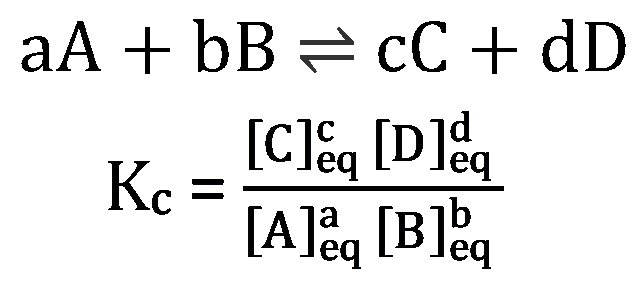Equilibria
The extent of a reaction is the degree to which the reactants are converted into products during a chemical reaction. Different reactions proceed to different extents as they reach equilibrium. e.g. HCl virtually fully ionises in water - it describes how much product is formed with the system reaches equilibrium. The rate of reaction, however, is a measure of the change in concentration of the reactants and products with time and is not directly related to the extent of a reaction
While the reactants are forming products, the products start reacting to form reactants again. Therefore, the rate of the forward reaction is decreasing as the concentration of reactants decreases, and the rate of the reverse reaction is increasing as the concentration of products increases. Hence, this continues until the rates of the forward and reverse reactions are equal. Chemical equilibria are dynamic, as the forward and reverse reactions are occurring continuously at the same rates, so that the concentrations of all the species present remain constant

| \(Q_c\) \(>\) \(K_c\) \(\uparrow\) Reactants | \(Q_c\) \(<\) \(K_c\) \(\uparrow\) Products | \(Q_c\) \(=\) \(K_c\) \(=\) Equilibrium |


The position of equilibrium refers to the relative amounts of reactants and products at equilibrium, which varies depending on the extent of the reaction
Changes to the position
| \(<<<<<<<<<<<<<<<<<<\) |
\(10^{-2} < K_c < 10^4\) |
\(>>>>>>>>>>>>>>>>>>\) |
| Mostly Reactants Net Back Reaction |
Reactants and Products | Mostly Products Net Forward Reaction |
If an equilibrium system is subjected to a change, the system will adjust itself to partially oppose the effect of the change
The addition of a catalyst or an inert gas has no change because they affect both the forward and reverse reactions
If the concentration of one species is increased, the system changes as to partially decrease the concentration of the species. The system favours the reaction that consumes the species. This is a direct result from the fact that where would be more fruitful collisions between this species and its other reactant. The opposite occurs when decreased
| \(+\) Reactants | Forward Favoured | \(+\) Product | Reverse Favoured |
| \(-\) Product | Net Forward | \(-\) Reactants | Net Reverse |
In the example, \(2SO_2 (g) + O_2 (g) \rightleftharpoons 2SO_3 (g)\), the forward reaction involves an increase in the number of gas particles from 2 to 3, causing an increase in pressure, while the reverse reaction involves a decrease in the number of gas particles causing a reduction in pressure. Therefore, using this idea, we can apply the Le Châtelier Principle.
| \(A + B \rightleftharpoons C + 2D\) | \(A + 2B \rightleftharpoons C + D\) | ||
| \(+\) Pressure | Reverse Favoured | \(+\) Pressure | Forward Favoured |
| \(-\) Pressure | Net Forward | \(-\) Pressure | Net Reverse |
Only temperature can increase yield and rate. If the temperature is increased, the system changes as to partially decrease the temperature. Therefore, the system favours the endothermic reaction – the forward reaction. \(K_c\) increases
If the temperature is increased, the system changes as to partially decrease the temperature. Therefore, the system favours the endothermic reaction – the reverse reaction. \(K_c\) decreases
When equilibria have a common reactant, each equilibrium can be regarded as competing for the reactant. However, the equilibrium with the larger equilibrium constant has a greater effect on the position of the equilibrium of the other reaction. In this competing system, the production is carboxyhaemoglobin is favoured in the presence of carbon monoxide.